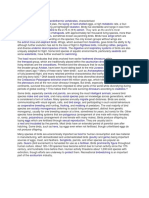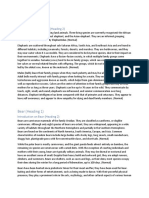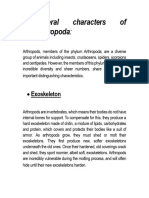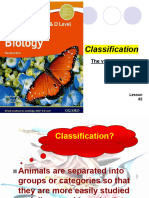0 ratings0% found this document useful (0 votes)
37 viewsBird Notes: Birds Are A Group of
Bird Notes: Birds Are A Group of
Uploaded by
Anon283716768t4uyg3bhjegBirds are a group of warm-blooded vertebrates distinguished by feathers, toothless beaked jaws, and the ability to lay hard-shelled eggs. They range in size from 5 cm bee hummingbirds to 2.75 m ostriches, with over 10,000 living species, more than half of which are passerines or "perching" birds. Birds evolved from feathered theropod dinosaurs and are descendants of the primitive avialans that first appeared 160 million years ago. They are highly adapted for flight through wing development and specialized respiratory and digestive systems, though some species lost this ability. Birds communicate visually and vocally and demonstrate various social behaviors such as cooperative breeding and flocking.
Copyright:
© All Rights Reserved
Available Formats
Download as DOCX, PDF, TXT or read online from Scribd
Bird Notes: Birds Are A Group of
Bird Notes: Birds Are A Group of
Uploaded by
Anon283716768t4uyg3bhjeg0 ratings0% found this document useful (0 votes)
37 views1 pageBirds are a group of warm-blooded vertebrates distinguished by feathers, toothless beaked jaws, and the ability to lay hard-shelled eggs. They range in size from 5 cm bee hummingbirds to 2.75 m ostriches, with over 10,000 living species, more than half of which are passerines or "perching" birds. Birds evolved from feathered theropod dinosaurs and are descendants of the primitive avialans that first appeared 160 million years ago. They are highly adapted for flight through wing development and specialized respiratory and digestive systems, though some species lost this ability. Birds communicate visually and vocally and demonstrate various social behaviors such as cooperative breeding and flocking.
Original Title
3
Copyright
© © All Rights Reserved
Available Formats
DOCX, PDF, TXT or read online from Scribd
Share this document
Did you find this document useful?
Is this content inappropriate?
Birds are a group of warm-blooded vertebrates distinguished by feathers, toothless beaked jaws, and the ability to lay hard-shelled eggs. They range in size from 5 cm bee hummingbirds to 2.75 m ostriches, with over 10,000 living species, more than half of which are passerines or "perching" birds. Birds evolved from feathered theropod dinosaurs and are descendants of the primitive avialans that first appeared 160 million years ago. They are highly adapted for flight through wing development and specialized respiratory and digestive systems, though some species lost this ability. Birds communicate visually and vocally and demonstrate various social behaviors such as cooperative breeding and flocking.
Copyright:
© All Rights Reserved
Available Formats
Download as DOCX, PDF, TXT or read online from Scribd
Download as docx, pdf, or txt
0 ratings0% found this document useful (0 votes)
37 views1 pageBird Notes: Birds Are A Group of
Bird Notes: Birds Are A Group of
Uploaded by
Anon283716768t4uyg3bhjegBirds are a group of warm-blooded vertebrates distinguished by feathers, toothless beaked jaws, and the ability to lay hard-shelled eggs. They range in size from 5 cm bee hummingbirds to 2.75 m ostriches, with over 10,000 living species, more than half of which are passerines or "perching" birds. Birds evolved from feathered theropod dinosaurs and are descendants of the primitive avialans that first appeared 160 million years ago. They are highly adapted for flight through wing development and specialized respiratory and digestive systems, though some species lost this ability. Birds communicate visually and vocally and demonstrate various social behaviors such as cooperative breeding and flocking.
Copyright:
© All Rights Reserved
Available Formats
Download as DOCX, PDF, TXT or read online from Scribd
Download as docx, pdf, or txt
You are on page 1of 1
Bird notes
Birds are a group of warm-blooded vertebrates constituting the class Aves, characterized
by feathers, toothless beaked jaws, the laying of hard-shelled eggs, a high metabolic rate, a four-
chambered heart, and a strong yet lightweight skeleton. Birds live worldwide and range in size from
the 5 cm (2 in) bee hummingbird to the 2.75 m (9 ft) ostrich. There are about ten thousand living
species, more than half of which are passerine, or "perching" birds. Birds have wings whose
development varies according to species; the only known groups without wings are the
extinct moa and elephant birds. Wings, which evolved from forelimbs, gave birds the ability to fly,
although further evolution has led to the loss of flight in some birds, including ratites, penguins, and
diverse endemic island species. The digestive and respiratory systems of birds are also uniquely
adapted for flight. Some bird species of aquatic environments, particularly seabirds and
some waterbirds, have further evolved for swimming.
Birds are a group of feathered theropod dinosaurs, and constitute the only living dinosaurs. Likewise,
birds are considered reptiles in the modern cladistic sense of the term, and their closest living
relatives are the crocodilians. Birds are descendants of the primitive avialans (whose members
include Archaeopteryx) which first appeared about 160 million years ago (mya) in China. According
to DNA evidence, modern birds (Neornithes) evolved in the Middle to Late Cretaceous, and
diversified dramatically around the time of the Cretaceous–Paleogene extinction event 66 mya,
which killed off the pterosaurs and all non-avian dinosaurs.
Many social species pass on knowledge across generations, which is considered a form of culture.
Birds are social, communicating with visual signals, calls, and songs, and participating in such
behaviours as cooperative breeding and hunting, flocking, and mobbing of predators. The vast
majority of bird species are socially (but not necessarily sexually) monogamous, usually for one
breeding season at a time, sometimes for years, but rarely for life. Other species have breeding
systems that are polygynous (one male with many females) or, rarely, polyandrous (one female with
many males). Birds produce offspring by laying eggs which are fertilised through sexual
reproduction. They are usually laid in a nest and incubated by the parents. Most birds have an
extended period of parental care after hatching.
Many species of birds are economically important as food for human consumption and raw material
in manufacturing, with domesticated and undomesticated birds being important sources of eggs,
meat, and feathers. Songbirds, parrots, and other species are popular as pets. Guano (bird
excrement) is harvested for use as a fertiliser. Birds figure throughout human culture. About 120 to
130 species have become extinct due to human activity since the 17th century, and hundreds more
before then. Human activity threatens about 1,200 bird species with extinction, though efforts are
underway to protect them. Recreational birdwatching is an important part of the ecotourism industry.
You might also like
- Case Presentation (Ortho Ward) :: Pathophysiology of FractureDocument2 pagesCase Presentation (Ortho Ward) :: Pathophysiology of FractureAbigail BrillantesNo ratings yet
- Animal DiversityDocument3 pagesAnimal DiversityChristian Dave Sanchez50% (2)
- Birds: Birds Are A Group of Warm-Blooded Vertebrates Constituting The Class Aves, CharacterizedDocument1 pageBirds: Birds Are A Group of Warm-Blooded Vertebrates Constituting The Class Aves, CharacterizedArnel BarawedNo ratings yet
- Birds, Also Known As Aves or Avian Dinosaurs, Are A Group ofDocument2 pagesBirds, Also Known As Aves or Avian Dinosaurs, Are A Group offlowermatrixNo ratings yet
- BirdDocument2 pagesBirdmelerine16No ratings yet
- Birds (Aves) Are A Group Of: WingsDocument1 pageBirds (Aves) Are A Group Of: WingsGabriel Angelo AbrauNo ratings yet
- Wings: Birds Are A Group ofDocument1 pageWings: Birds Are A Group ofSamitDosiNo ratings yet
- BirdsDocument1 pageBirdsRiddhi SoniNo ratings yet
- For Other Uses, See - "Aves" and "Avifauna" Redirect Here. For Other Uses, See andDocument8 pagesFor Other Uses, See - "Aves" and "Avifauna" Redirect Here. For Other Uses, See andJrPelayoNo ratings yet
- Birds (: ArchaeopteryxDocument1 pageBirds (: ArchaeopteryxAbednego Kristiawan AciNo ratings yet
- Study of Birds: Environmental ScienceDocument6 pagesStudy of Birds: Environmental ScienceAbhi Raut100% (1)
- HummingbirdsDocument6 pagesHummingbirdsதுளசி இன்போஸ்No ratings yet
- Types of BirdsDocument10 pagesTypes of BirdsBrian ArigaNo ratings yet
- BirdsDocument1 pageBirdsRahul KambleNo ratings yet
- Animals: Cells Eukaryotic CellsDocument17 pagesAnimals: Cells Eukaryotic CellsFallianda YandaNo ratings yet
- Study of Common BirdsDocument5 pagesStudy of Common BirdsShaunak De100% (6)
- Birds Are FlyingDocument2 pagesBirds Are FlyingidkNo ratings yet
- Bird ProjectDocument1 pageBird ProjectLittleCreepKidNo ratings yet
- Analyze The Study of The Bird-1.EditedDocument9 pagesAnalyze The Study of The Bird-1.Editedian murithiNo ratings yet
- BirdsDocument4 pagesBirdsSumaiya FaizalNo ratings yet
- Birds (Aves) Are A Group Of: ArchaeopteryxDocument1 pageBirds (Aves) Are A Group Of: ArchaeopteryxHeRoe SoesilowNo ratings yet
- Introduction On Elephant (Heading 2)Document4 pagesIntroduction On Elephant (Heading 2)Divya TaraNo ratings yet
- MamifereDocument5 pagesMamifereOana CristeaNo ratings yet
- Birds Presentatipon Sci ProjectDocument46 pagesBirds Presentatipon Sci ProjectrohmphaNo ratings yet
- Evolution BirdsDocument17 pagesEvolution BirdsKayode OladunjoyeNo ratings yet
- Basic Types of Animals and Their CharacteristicsDocument5 pagesBasic Types of Animals and Their CharacteristicsAurea Jasmine DacuycuyNo ratings yet
- What Are BirdsDocument2 pagesWhat Are BirdsAbigail DiocadoNo ratings yet
- Types of BirdsDocument3 pagesTypes of BirdsLeonel OcanaNo ratings yet
- From Wikipedia, The Free Encyclopedia Jump To:, For Other Uses, See - Aves and Avifauna Redirect Here. For Other Uses, See orDocument26 pagesFrom Wikipedia, The Free Encyclopedia Jump To:, For Other Uses, See - Aves and Avifauna Redirect Here. For Other Uses, See orfrndgurlNo ratings yet
- Animal ClassesDocument5 pagesAnimal ClassesHoneyleth TinamisanNo ratings yet
- Dupems Biology Project 11Document10 pagesDupems Biology Project 11Vedant BarhateNo ratings yet
- Kind of BirdDocument1 pageKind of BirdAbednego Kristiawan AciNo ratings yet
- Birds ExpandedDocument3 pagesBirds Expandedpraveencertificates11No ratings yet
- 06Document1 page06hdsehwuirhs4324No ratings yet
- AnimalDocument22 pagesAnimalJudin BellNo ratings yet
- Functional Comparative Anatomy & Physiology ofDocument10 pagesFunctional Comparative Anatomy & Physiology ofdennymaeperpetuaNo ratings yet
- Vertebrate and InvertebratesDocument9 pagesVertebrate and InvertebratesgwenethzNo ratings yet
- Dupems Chem Project 11Document6 pagesDupems Chem Project 11Vedant BarhateNo ratings yet
- Birds of Prey EssayDocument1 pageBirds of Prey EssayRoberto LandaNo ratings yet
- BirdDocument2 pagesBirdAndreas ȘtefanNo ratings yet
- Insects or Insecta (FromDocument1 pageInsects or Insecta (FromStelian HudeaNo ratings yet
- Best Control For FliesDocument30 pagesBest Control For FliesDavidNo ratings yet
- Group 1: Fatima Ang Kayla Mina Klein Ashley Singson Merah Tiong Rose Kelly Tayag Johne Sigrid MuyanoDocument11 pagesGroup 1: Fatima Ang Kayla Mina Klein Ashley Singson Merah Tiong Rose Kelly Tayag Johne Sigrid MuyanoKelly TayagNo ratings yet
- Многообразие На Птиците - Copy en-USDocument15 pagesМногообразие На Птиците - Copy en-USNikolay KolevNo ratings yet
- Bird EssayDocument2 pagesBird EssayShivam JainNo ratings yet
- Relationship With Humans: Parrots, Also Known As Psittacines (Pronounced PsittaciformesDocument16 pagesRelationship With Humans: Parrots, Also Known As Psittacines (Pronounced PsittaciformesRicky RanaNo ratings yet
- Topic EcologyDocument5 pagesTopic EcologyJavier SmithNo ratings yet
- Handouts VertebratesDocument5 pagesHandouts VertebratesDiane PamanNo ratings yet
- Zoology ProjectDocument20 pagesZoology ProjectUMESH WADASKARNo ratings yet
- Characteristics of Class AvesDocument4 pagesCharacteristics of Class AvesPriti Ranjan NarendraNo ratings yet
- BIRDS ActivityDocument13 pagesBIRDS ActivityMudasir SalikNo ratings yet
- Class Insecta Order Diptera Life HistoryDocument3 pagesClass Insecta Order Diptera Life HistoryChuramoni SahaNo ratings yet
- Migratory Birds: Anannya Mukherjee 7C 30 English LiteratureDocument7 pagesMigratory Birds: Anannya Mukherjee 7C 30 English LiteratureANANNYA MUKHERJEENo ratings yet
- Zoology BonDocument118 pagesZoology BonRupkathar Pagol Kra RajkumariNo ratings yet
- Headings BIRDSDocument2 pagesHeadings BIRDSalaketaNo ratings yet
- BirdsDocument5 pagesBirdsOlaru LorenaNo ratings yet
- AnimalsDocument2 pagesAnimalsXaid IbrahimNo ratings yet
- Insect PDFDocument2 pagesInsect PDFSSSNo ratings yet
- Task Performance in EnsciDocument8 pagesTask Performance in EnsciPythia HecatleneNo ratings yet
- ClassificationDocument40 pagesClassificationSajed- JRNo ratings yet
- Chemistry NotesDocument2 pagesChemistry NotesAnon283716768t4uyg3bhjegNo ratings yet
- Cat Notes: Farm Cat Feral CatDocument1 pageCat Notes: Farm Cat Feral CatAnon283716768t4uyg3bhjegNo ratings yet
- Dog Notes: o o o o o o o o o o o o o o oDocument2 pagesDog Notes: o o o o o o o o o o o o o o oAnon283716768t4uyg3bhjegNo ratings yet
- Science Class NotesDocument1 pageScience Class NotesAnon283716768t4uyg3bhjegNo ratings yet
- The Microbial World and YouDocument30 pagesThe Microbial World and YouSaba RahmanNo ratings yet
- Scientific MethodDocument6 pagesScientific MethodDean JezerNo ratings yet
- Marielle Caccam Jewel RefranDocument100 pagesMarielle Caccam Jewel RefranarelismohammadNo ratings yet
- Florida Peach and Nectarine VarietiesDocument17 pagesFlorida Peach and Nectarine Varietiesjimhale777No ratings yet
- AVR Unit 1 Part 3Document25 pagesAVR Unit 1 Part 3Honey BeeNo ratings yet
- Classification of CellsDocument14 pagesClassification of CellsTalha AfzalNo ratings yet
- Individual Activity Reproductive SystemDocument3 pagesIndividual Activity Reproductive Systemshiela100% (1)
- MCQ in Basic Anatomy and Physiology PDFDocument605 pagesMCQ in Basic Anatomy and Physiology PDFFebriyanti100% (12)
- 2018學位生各院教授名單List of Professors for Degree-seeking Students-201804updatedDocument13 pages2018學位生各院教授名單List of Professors for Degree-seeking Students-201804updatedMuhammad Zaka Ud DinNo ratings yet
- Fisher FolksDocument23 pagesFisher FolksMelanie Malapad100% (1)
- Antiretroviral DrugsDocument4 pagesAntiretroviral DrugsPrince Kevin AdinaNo ratings yet
- The Human Milk Oligosaccharides Are Not Affected by Pasteurization and Freeze-DryingDocument8 pagesThe Human Milk Oligosaccharides Are Not Affected by Pasteurization and Freeze-DryingDianne Faye ManabatNo ratings yet
- Stent Thrombosis: Dr. Surinder SinghDocument40 pagesStent Thrombosis: Dr. Surinder SinghsshansraNo ratings yet
- Timber and Materials - Wood Technology EWP NotesDocument19 pagesTimber and Materials - Wood Technology EWP NotesFaith Gwamure JafariNo ratings yet
- Hematology 1 New EdDocument50 pagesHematology 1 New EdRUBEN DAMAYONo ratings yet
- Class X ICSE Subject Chapter Wise ListDocument9 pagesClass X ICSE Subject Chapter Wise ListShayan BiswasNo ratings yet
- Ccle Mid002Document23 pagesCcle Mid002Frankenstein MelancholyNo ratings yet
- Lecture 5 MicrobiologyDocument89 pagesLecture 5 Microbiologyjessenia.tutor2010No ratings yet
- Quantitative Morphological Changes in The Interplacentomal Wall of The Gravid Uterine Horn of Cattle During PregnancyDocument8 pagesQuantitative Morphological Changes in The Interplacentomal Wall of The Gravid Uterine Horn of Cattle During PregnancyfeyisaNo ratings yet
- Circulatory InsectsDocument7 pagesCirculatory Insectsmith777No ratings yet
- Agroecology HandoutDocument2 pagesAgroecology HandoutNicoleEmptyCagesNo ratings yet
- Rutgers Professional Golf Turf Management School: Two Year Certificate Program 2013-14Document16 pagesRutgers Professional Golf Turf Management School: Two Year Certificate Program 2013-14RutgersCPENo ratings yet
- (Micropropagation of Sulawesi Endemic Plants, Alocasia Deer Horn (Alocasia Jacklyn SP) With Shoot and Root Induction)Document10 pages(Micropropagation of Sulawesi Endemic Plants, Alocasia Deer Horn (Alocasia Jacklyn SP) With Shoot and Root Induction)bionic artNo ratings yet
- Kulkarni Anatomy A Problem Solving Approach 2nd EditionDocument979 pagesKulkarni Anatomy A Problem Solving Approach 2nd EditionDevanshi Pandey88% (8)
- A Case Study About Klinefelter SyndromeDocument6 pagesA Case Study About Klinefelter Syndromehoy100% (1)
- Human Anatomy Lab Manual 1535056949Document187 pagesHuman Anatomy Lab Manual 1535056949HalluxNo ratings yet
- Masayu MaslanDocument3 pagesMasayu MaslanydaimNo ratings yet
- Yoga and Research - Plea For A New Approach: M.V. RajapurkarDocument6 pagesYoga and Research - Plea For A New Approach: M.V. Rajapurkarforgotten heroNo ratings yet
- Tropical RainforestDocument2 pagesTropical Rainforestrgrg4ggNo ratings yet





























































































